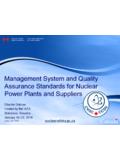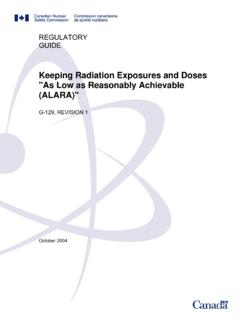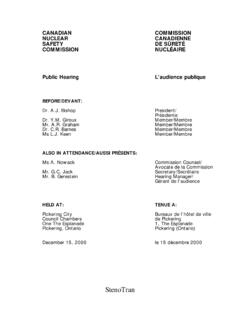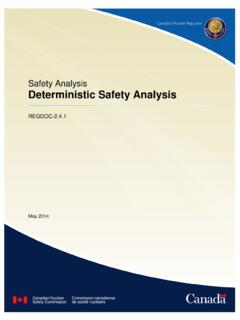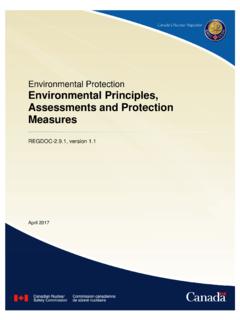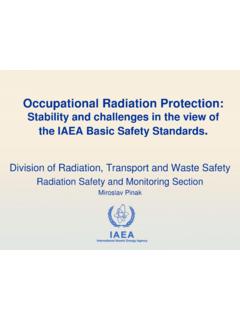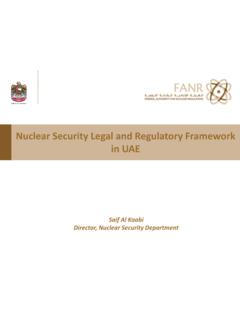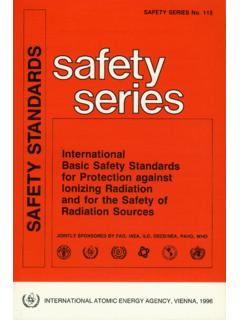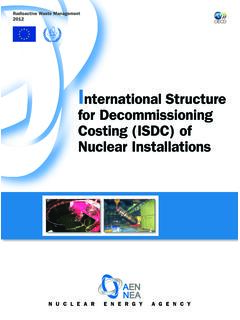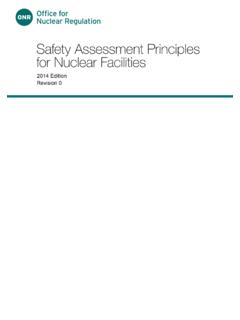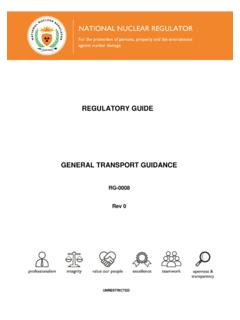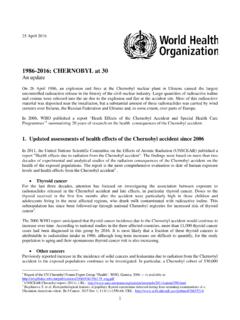Transcription of The Science of Safety CNSC Research Report 2015-16
1 The Science of Safety : cnsc Research Report 2015 16 Canadian Nuclear Safety Commission ( cnsc ) 2016 PWGSC catalogue number CC171-24E-PDF ISSN 2369-4351 Extracts from this document may be reproduced for individual use without permission provided the source is fully acknowledged. However, reproduction in whole or in part for purposes of resale or redistribution requires prior written permission from the Canadian Nuclear Safety Commission. galement publi en fran ais sous le titre: La Science de la s ret : Rapport de recherche de la CCSN 2015 -2016 Document availability This document can be viewed on the cnsc website at To request a copy of the document in English or French, please contact: Canadian Nuclear Safety Commission 280 Slater Street Box 1046, Station B Ottawa, Ontario K1P 5S9 Canada Tel.
2 : 613-995-5894 or 1-800-668-5284 (in Canada only) Facsimile: 613-995-5086 Email: Website: Facebook: YouTube: Twitter: @CNSC_CCSN Publishing history December 2016 Edition Table of contents Message from the President .. 2 Introduction .. 3 Ensuring the Safety of nuclear power plants .. 5 Protecting workers .. 14 Protecting the environment .. 17 Spotlight on cnsc Research staff: Andrei 22 Spotlight on cnsc Research staff: Michel Couture .. 23 Advancing regulatory perspectives .. 24 international commitments .. 26 Strengthening the next 40 Future Research at the cnsc .. 44 Glossary of terms .. 45 Annex: cnsc technical papers, presentations and articles.
3 47 1 2 Message from the President The Canadian Nuclear Safety Commission ( cnsc ) has a mandate to protect the health, Safety and security of Canadians and the environment; to implement Canada s international commitments on peaceful nuclear energy use; and to disseminate scientific, technical and regulatory information to the general public. Our regulatory Research is essential to delivering on that mandate, providing us with the objective knowledge that forms the basis for safe and secure regulatory decisions. The following is the cnsc s third annual Research Report , which summarizes the various Research projects we have funded and completed in the 2015 16 fiscal year.
4 By being transparent in our activities and sharing the results of the Research we conduct across the nuclear industry both in Canada and abroad, we are ensur ing Canadians are well educated on our regulatory activities. All of the information in this Report , unless otherwise indicated, is publicly available on our website. All readers, whether technical or not, are encouraged to read the summaries provided in this Report and, if interested, click on the associated links in each summary to access the more detailed Research results. That s the Science of Safety . Michael Binder President and Chief Executive Officer, Canadian Nuclear Safety Commission 3 Intro duction Purpose of this Report Part of the cnsc s mandate is to disseminate scientific, technical and regulatory information to the general public.
5 While information on the cnsc s Research and Research -related projects is publicly available on its web site , the associated Research documents often contain very technical and scientific language. As such, the cnsc publishes The Science of Safety Report each year to summarize the Research and make the results more accessible to a general audience. A glossary of terms is provided to further assist readers in understanding the technical language used in this document. Words that are underlined are linked to their respective definition in the glossary. Reg ulatory Research Our regulatory Research is used in many ways. It supports our regulatory decisions.
6 It helps us protect the health, Safety and security of Canadians and the environment by identifying issues that may lead to eventual hazards and developing tools and techniques to address those issues. It is also used to create stronger Safety standards for the benefit of the nuclear industry and the general public alike . The three main objectives of the cnsc s Research program are to: collect independent advice in support of regulatory decisions develop tools capable of addressing health, Safety , security or environmental issues develop nuclear Safety standards These objectives can be further defined into 10 main goals: strengthening the cnsc s licensing, compliance and regulatory framework in preparation for long-term/ post-refurbishment operation of Canadian nuclear power plants enhancing the cnsc s capability to independently assess hazards (particularly natural hazards)
7 And to analyse/respond to severe reactor accidents supporting cnsc staff in preparation and conduct of vendor design reviews enhancing the cnsc s understanding of the environmental transport and behaviour of hazardous/nuclear substances and associated environmental exposures informing the cnsc s radiation protection knowledge base to reflect the best available Science with respect to the protection of workers and the public supporting cnsc staff in their evaluation of licensing or other submissions related to waste repositories furthering the cnsc s understanding of the long-term behaviour of both uranium mining and milling waste supporting the update of the cnsc s regulatory framework to reflect modern human performance approaches supporting Canada s safeguards commitments and influencing international safeguards efforts strengthening Canada s nuclear forensics capability This Report categorizes our Research by three general categories: Ensuring the Safety of nuclear power plants , Protecting workers and Protecting the environment.
8 4 Each chapter provides quick summaries of all the Research projects and similar work completed by the cnsc from April 1, 2015 to March 31, 2016. Project topics are not limited to commercial nuclear power; there are multiple projects spread across every aspect of the Canadian nuclear industry that is regulated by the cnsc , including uranium mining, nuclear Research facilities and more. Our Research universe The cnsc funds Research in the private sector, academic institutions, governmental organizations and non-governmental organizations, primarily through competitive contracting processes. This Research is not limited to Canada but includes international funding as well.
9 Our Research program shares some costs and other information with national and international partners. Type of Research organization Funding percentage (%) Federal 11 Domestic Business 14 Non-Profit 20 Academic 30 Foreign 25 This year our primary Research partners were academic institutions, making up 30 percent of the total Research spending up from 14 percent in 2014 15. Some of these institutions included Carleton University, the University of Manitoba, McMaster University, the University of Ottawa, Queen s University, the University of Calgary and the University of Toronto, as well as the University Network of Excellence in Nuclear Engineering.
10 Agreements with non-profit organizations were another area of growth, with 20 percent of Research spending going to organizations such as the CSA Group, the Canadian Nuclear Society and the Deep River Science Academy up from just one percent in 2014 15. The cnsc also had significant collaboration with foreign vendors (as is typical each year), including foreign governments and consultants such as the Nuclear Energy Agency and Areva. Domestic business 14% Foreign 25% Academic 30% Non-profit 20% Federal 11% cnsc Research funding by organization type 5 Ensuring the Safety of nuclear power plants There are four nuclear generating stations operating in Canada.
